The image above is a slice from one of several photos I took during a visit with Leslie at her memory care facility. I rarely crop photos to remove information about what I’ve photographed, but I had to cut this one down to fit the banner template for this blog. I didn’t worry that the result was an image missing essential information, because it was just for the banner–and that’s a good metaphor for the challenge of understanding Alzheimer’s. For this particular photograph, however, I can restore some of what’s missing by displaying the full frame from which the slice was taken.
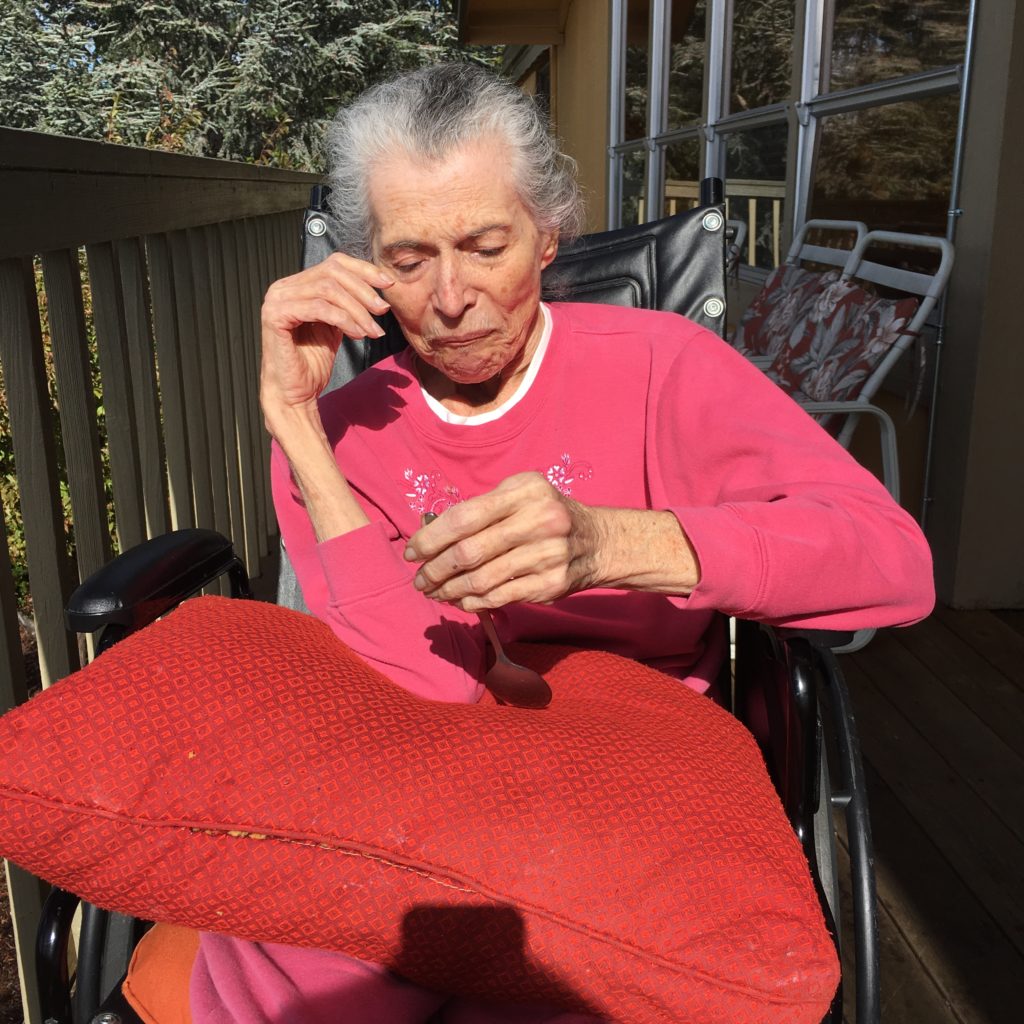
The full frame gives a more complete picture of what Leslie is doing–where she’s sitting and on what, her immediate surroundings, what she’s holding in her hand, the weather and so on. It also provides visual information–her facial expression, for example, the direction and intensity of her gaze and the position of her hands–from which we can infer something about what she’s thinking or experiencing.
To go beyond how things looked with Leslie in a single instant, other photos taken at about the same time can be useful, particularly if we know the time frame and sequence in which they were made. Consider, for example, the two photos below: the first was taken 10 and the second 5 seconds before the one above.
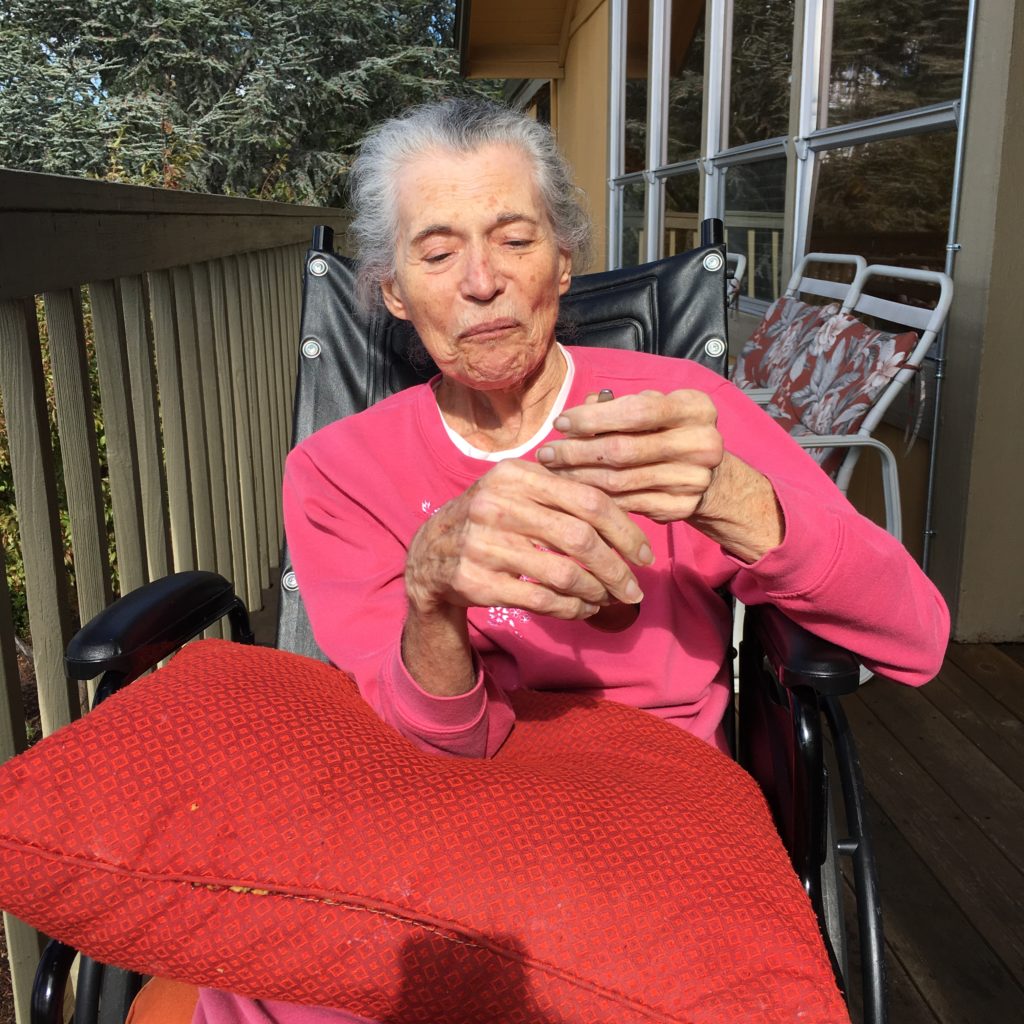
In the timed sequence of three photos we can follow Leslie’s movements and get a better sense of how her visual and tactile attention shifts. We have nothing close to a complete picture, but we can now see enough to surmise that she’s being curious and reflective about something, and that she’s focused her attention on an object that she has the dexterity to display in different ways. Adding two other images to the mix, we get a five-photo sequence of Leslie examining a spoon, or a reflection in the spoon:
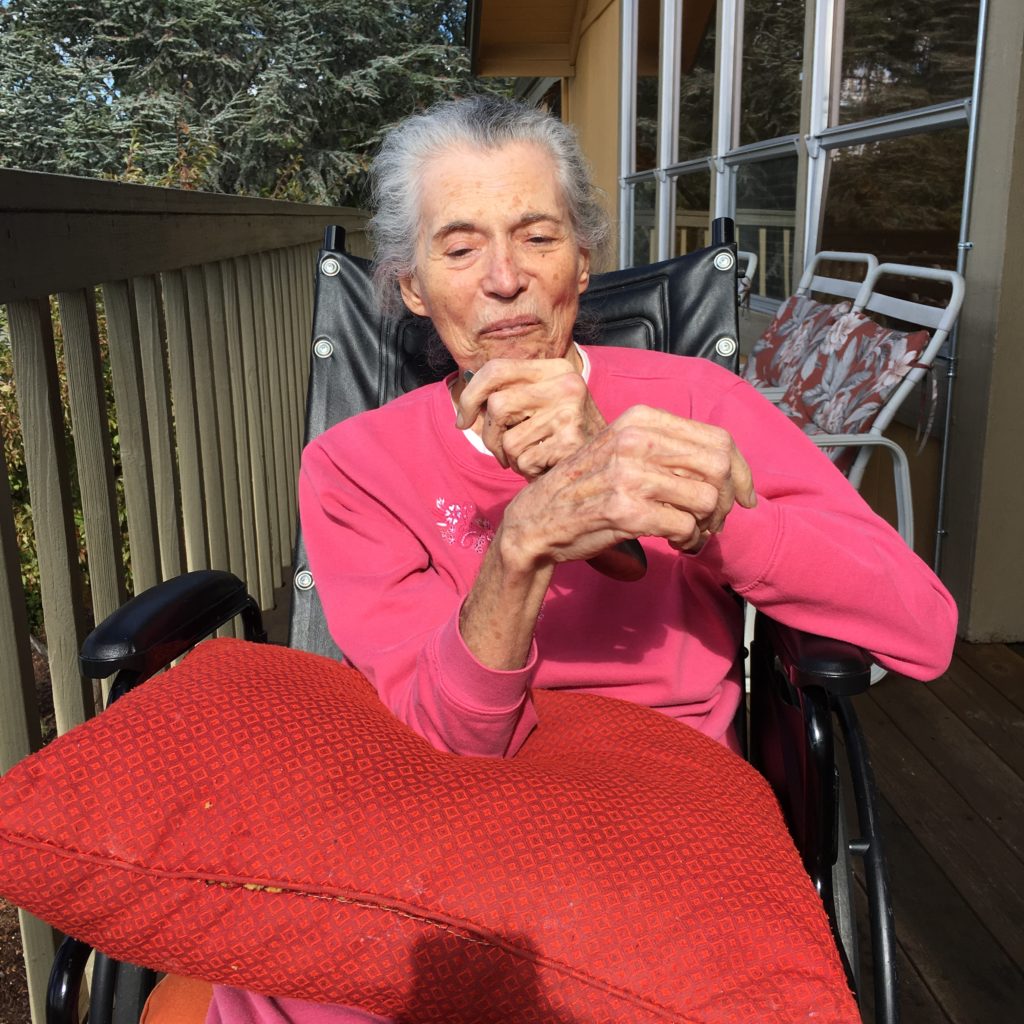

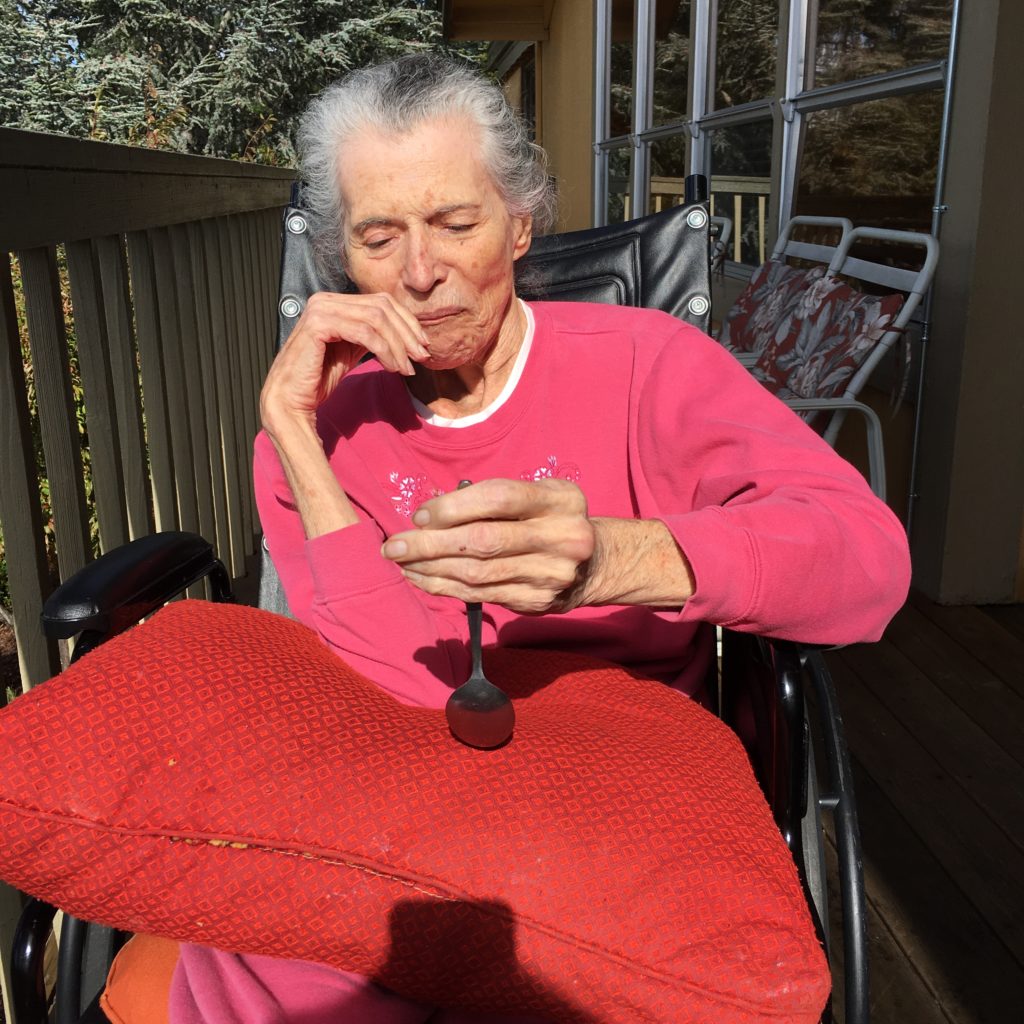
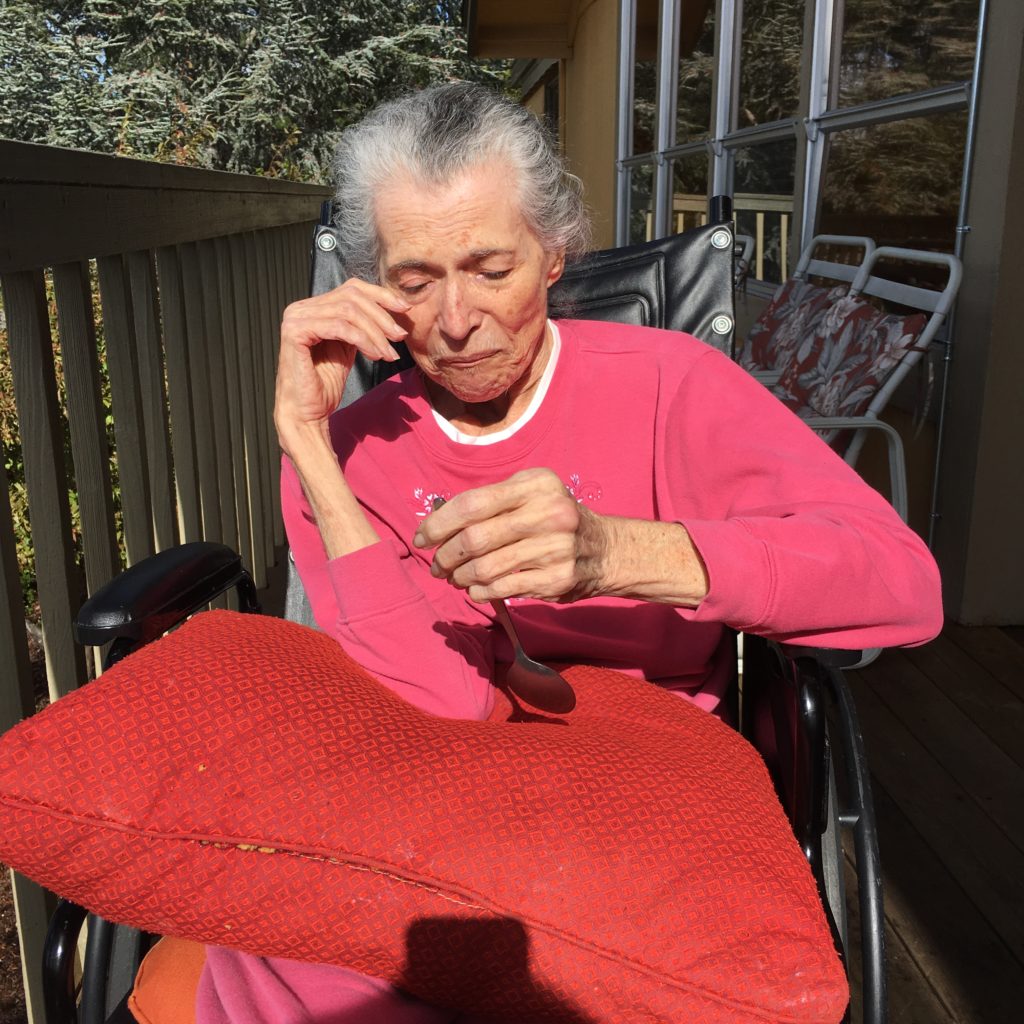

The sequence provides even more visual information about what Leslie is doing –and, by inference and interpretation, what she might be thinking and feeling. We can see the positions she moved from and to, not just with her hands, but with her arms, head, mouth and eyes. Above and beyond particulars–the hint of a smile in the first and second frame, the hint of a frown in the last– there’s now information enough to recognize this sequence of movements as evidence of thoughtful activity. That is, going just by what we can see in the photos, Leslie’s behavior looks a lot like what we’d expect from someone who is willfully aware and thinking about what she’s doing.
That’s not to say we can actually tell what’s going on for Leslie during the time these photos were made. We don’t know, for example, if she’s looking at the spoon or at a reflection in the spoon–or, if the latter, what the reflection is of. And we can’t tell what she’s thinking about what she sees. Is the spoon an antique on which she’s trying to read the maker’s mark? Is she assessing whether this is her personal spoon or someone else’s? Is it an unfamiliar object she’s trying to identify or place within the routines of her day?
The photos alone won’t answer any of those questions, but they intimate that something was going on within Leslie’s field of awareness that led her to change the position of the spoon, her head and her eyes. And the way she’s made those changes is consistent with how we think a thinking person looks.
That’s an important contribution of the five photos over the one, for a couple of reasons: First, it gives us at least an inkling of Leslie as a person, as someone who has experience, makes choices and tries to understand what she’s doing while she’s doing it.
For a fuller portrait of Leslie, of course, we’d like to know things that go well beyond how she handled and looked at the spoon and the time during which the photographs were made. How about getting some details and impressions from her of the journey she’s taken into Alzheimer’s, or an account of her transition from one memory care facility to another? Or hearing what she has to say about how her life changed during that journey, what she values now that she didn’t before, or what aggravates her most about her current living situation?
Hearing directly from Leslie about such things could add a lot to what we know about her as a person, but Leslie can’t tell us those things, because five or six years before these photos were taken she stopped talking and writing. That frames a second respect in which the five photo sequence is preferable to a single image: it allows us to “hear” more from Leslie, Stated from her point of view, it expands the depth and scope of her “voice.”
Voice may seem an odd word for describing an exchange with Leslie in which we watch her do something. If we want to understand what she’s thinking or feeling, however, that’s pretty much all we have to work with. Lacking words of her own, she needs something else to express herself. Whatever that might be, it has to fall within what she can manipulate and control. Ideally, it would be a medium or material she’s familiar with and can alter without much effort–and also something we can see, hear or feel.
The micro movements of Leslie’s face, limbs and torso illustrated by the five photographs are a pretty good candidate in that regard. If we follow those movements closely enough, we can get a sense of how she’s responding to something. If it’s to something we’ve said–and the responses are coherent and congruent enough with what we meant–that might suggest her receptive language skills are still somewhat intact. If it’s something we show her or enact through our own gestures and facial expressions, we might feel we’re sharing our experience with her. If we see her respond to something she’s listening to, like a piece of music or the cry of a hawk circling above the deck of her residence care facility, we might get to feel she’s sharing something with us.
——————————————–
Leslie was something of an anomaly among people who live with Alzheimer’s because she lost her expressive language skills early in the game, rather than later. As a result, unassisted two-way verbal conversation with her was a practical impossibility. Leslie was very expressive and responsive, however, and seemed to listen actively and track conversations going on around her. Based on her non-verbal cues and expressions, we felt she understood much of what she heard. The only way we knew that, however, was by attending to how she looked, how she moved, where she directed her gaze, what she touched or reached for or pulled away from, how she sighed or laughed, how she breathed, where she put her hands and when, and whether or how she did any of this while responding to what we said.
To participate with Leslie in this kind of communication, we had to learn how to read subtle variationsin her behavior, but our impression is she tried to meet us halfway. As her expressive verbal language declined, she seemed to hone some existing skills for non-verbal communication as well as develop a few new ones.
Leslie’s ability to communicate through physical gestures and expressions was always in flux, and her repertoire changed over time, both cyclically and in response to her overall decline from advancing Alzheimer’s. As a result, it was difficult to know any of this with certainty. What we did know with certainty, was that she hadn’t so much lost her voice, as changed her medium of expression. Her non-verbal messaging was clear enough for those who cared for her to keep doing so, and to recognize, know and interact with her on interpersonal, or even intimate terms.
If Alzheimer’s had not taken away Leslie’s ability to talk, she could have called people out for behavior she found offensive and offered verbal thanks to others for their kindness. By the time she had moved into her first memory care residence, that was no longer an option. Whenever she was offended or crossed, however, she could still roll her eyes or close them, shake her head from side to side, turn away, display a push-away palm, or cover her face with her hand. When she was appreciative, she could still display a smile that might be faint, mischievous or megawatt. depending on how grateful or sassy she was feeling. She could still reach out and touch someone’s arm or a cheek, or squeeze and shake someone’s hand. She might have lost her ability to speak, but to hear what what she had to say, we needed only to engage with her as fully as we could, and look closely at what she was doing.

There’s a lot more to be said about communicating with people who are living with Alzheimer’s or dementia, and some of it might be better said with pictures than with words. In each of these two images, Leslie is looking at paper prints of some photographs we took of her and of people she knew and cared about. We can’t tell from these two images what she’s thinking, but we might get some insights into that if we were in the room with her, talking about the photos as she looked at them and looking closely at how she responded to what we said. If Leslie were someone we cared about, or someone we’d like to know better than we do, that might even be kind of fun–for both of us!

For more on using photographs and visual materials to support engaged communication with people with Alzheimer’s or expressive aphasia, see our post on “Alzheimer’s and Visual Literacy” [forthcoming].
